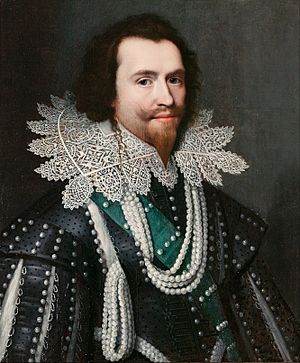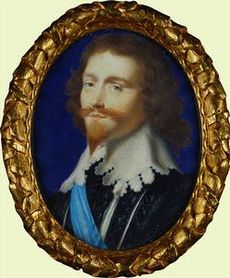George Villiers, 1st Duke of Buckingham facts for kids
Quick facts for kids
The Duke of Buckingham
|
|
|---|---|
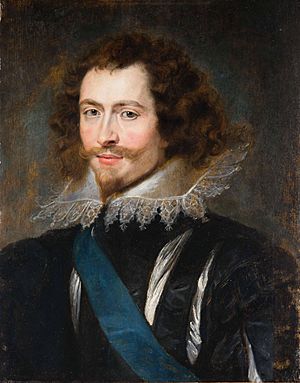
Portrait by Peter Paul Rubens, 1625
|
|
| 1st Duke of Buckingham | |
| In office 1616–1628 |
|
| Preceded by | Edward Stafford |
| Succeeded by | George Villiers, 2nd Duke of Buckingham |
| Personal details | |
| Born | 28 August 1592 Brooksby, Leicestershire, England |
| Died | 23 August 1628 (aged 35) Portsmouth, Hampshire, England |
| Resting place | Westminster Abbey |
| Spouse | Katherine Manners, Baroness de Ros |
| Children |
|
| Parents | |
| Signature | |
George Villiers, 1st Duke of Buckingham, born on August 28, 1592, was an important English courtier and statesman. He was a close friend and advisor to King James I of England. He remained very powerful during the first three years of the reign of James's son, King Charles I. Sadly, he was assassinated by an army officer in 1628.
Contents
Early Life and Education
George Villiers was born in Brooksby, Leicestershire, England. His father, Sir George Villiers, was a minor gentleman. His mother, Mary, became a widow early in his life.
Mary made sure her son was trained for a life at court. She sent him to travel in France with John Eliot. Villiers learned to dance and fence well. He also spoke some French. People described him as very handsome and charming.
Rising to Power at Court
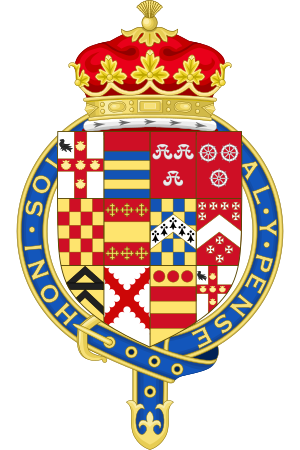
In August 1614, when Villiers was 21, he met King James I at a hunt. People who wanted to remove the King's favorite, Robert Carr, saw a chance to help Villiers instead. They raised money for new clothes for Villiers. They also worked hard to get him a job as the Royal Cup-bearer. This job allowed him to talk with the King often.
Villiers also performed as a dancer in court shows called masques. This was a way to show off his grace and good looks. It was a common way to gain royal favor back then.
Quick Promotions and Titles
With the King's support, Villiers quickly gained many important titles. In 1615, he was made a Knight and a Gentleman of the Bedchamber. In 1616, he became the King's Master of the Horse. He was also given the titles of Baron Whaddon and Viscount Villiers. He was also made a Knight of the Garter.
The next year, he became an Earl. In 1618, he was promoted to Marquess of Buckingham. Finally, in 1623, he became the Duke of Buckingham. This high rank allowed him to dance alongside the King's son, Prince Charles. Their friendship grew as Villiers even tutored the prince in dance.
In 1619, Villiers was appointed Lord High Admiral of England. This meant he was in charge of the navy. In 1623, the title of Duke of Buckingham was given to him again. This happened while he was negotiating for the King in another country. At that time, he was the only English duke who was not part of the royal family.
Relationship with King James I
Villiers was the last of several handsome young favorites of King James I. The King gave him much affection and support. King James's special nickname for Buckingham was "Steenie." This name came from St. Stephen, who was said to have "the face of an angel."
Influence Under King James I
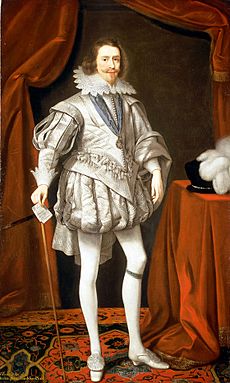
Until King James I died in 1625, Buckingham was the King's constant companion. He was also his closest advisor. He controlled all royal appointments and gifts. Buckingham used his power to make his relatives very rich. He also helped them gain high social positions. This made many people dislike him.
Buckingham became connected with the famous philosopher Francis Bacon. Bacon gave advice to the young favorite. He also helped draft the official document when Buckingham became a peer. With Buckingham's help, Bacon became Lord Chancellor in 1618. Bacon then helped Buckingham's friends and allies in court.
Later, Parliament investigated corruption. Bacon was found guilty of corruption and had to retire. Neither Buckingham nor the King tried to help Bacon. Many people thought Buckingham sacrificed Bacon to protect himself. This was because Buckingham had been spending public money freely and accepting gifts.
Influence in Ireland
From 1616, Buckingham also gained much power in Irish affairs. He appointed his friend, Sir Oliver St John, as Lord Deputy. He also gained control of Irish customs and sold Irish titles. He began to build large estates for himself and his family in Ireland. He also helped create an Irish Court of Wards in 1622. Buckingham's influence supported a strong policy of English settlement in Ireland during the 1620s.
When Parliament began investigating abuses in England and Ireland in 1621, Buckingham pretended to support them. However, the King decided to send a group to investigate Ireland. This group included members of Parliament who might expose Buckingham's secret interests there. Buckingham knew the King had promised the Spanish ambassador that Parliament would not stop a marriage alliance with Spain. So, Buckingham secretly caused a conflict between Parliament and the King over the "Spanish Match." This led to Parliament being dismissed early in December 1621. It also weakened the Irish investigation.
Charles I, the Lord Admiral, and Foreign Affairs
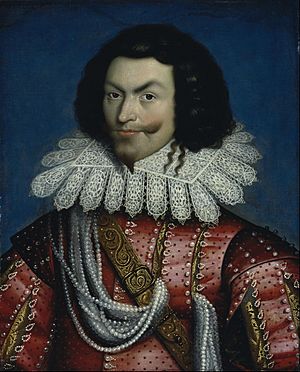
In 1623, Buckingham, who was now Lord Admiral and in charge of foreign affairs, went with Prince Charles to Spain. They were there to negotiate a marriage for Charles with the Infanta Maria. These talks had been difficult for a long time. Many believe Buckingham's rude behavior caused the agreement to completely fall apart. They returned to England very upset.
The Spanish ambassador asked Parliament to execute Buckingham for his behavior in Madrid. However, Buckingham became popular by calling for war with Spain when he returned.
He led more marriage negotiations. But in December 1624, when the engagement to Henrietta Maria of France was announced, many people were angry. This was because she was Catholic. Buckingham's popularity suffered again. He then decided to help the rebellious Huguenot Admiral Benjamin, Duke of Soubise. Buckingham, a strong Protestant, ordered Sir John Penington to help. But the Navy only attacked Richelieu's enemies. They lost La Rochelle in August 1625.
Buckingham was also blamed for the failure of a military trip in 1625. This trip was led by Ernst von Mansfeld, a famous German general. The goal was to take back the Electorate of the Palatinate. This land belonged to Frederick V, Elector Palatine, who was King James I of England's son-in-law. When the Duke of York became King Charles I, Buckingham was the only person from James's court to keep his powerful position.
The Cádiz Expedition
In 1625, Buckingham suggested sending an expedition to Spain. He wanted to repeat the actions of Sir Francis Drake. Drake had seized the main Spanish port at Cádiz and burned the Spanish fleet. Buckingham's past failures had made Parliament refuse to give more money for his expensive adventures. But Parliament was interested in striking a blow against Catholic Spain. So, the expedition was approved.
However, even before the troops left, their food was eaten while waiting for supplies. Buckingham himself was not in command. He gave command to Sir Edward Cecil. Cecil was a good soldier on land but knew nothing about the sea.
Buckingham's plan was good on paper. It called for landing further up the coast and marching the army to the city. But the troops were poorly equipped, undisciplined, and badly trained. The attack had to be called off. The English army briefly took a small port before getting back on their ships.
After the embarrassing failure at Cádiz, Cecil tried to stop a Spanish silver fleet. This fleet was on its way back to Spain from America. But the Spanish knew about the ambush and easily avoided it. With supplies running out and men dying from hunger and sickness, the English ships returned home in shame. People blamed Buckingham for another disaster. This led to serious political problems. Parliament began to try to remove Buckingham from office in 1626. King Charles dissolved Parliament to protect his favorite.
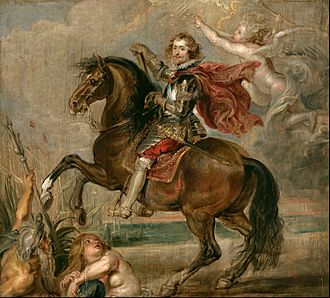
French Alliances and Further Failures
Buckingham then talked with the French Chief Minister, Cardinal Richelieu. He offered English ships to help Richelieu fight the French Protestant Huguenots. In return, France would help England against the Spanish in the Palatinate. Seven English warships helped in operations against La Rochelle. But Parliament was horrified at the idea of English Protestants fighting French Protestants. This plan only increased their fears of secret Catholicism at court.
In the end, seven English ships were given to the French. Most English sailors refused to fight against their fellow Protestants. They left the ships in Dieppe. After the French forces successfully took back Ré island, a peace treaty was signed in 1626. This treaty kept religious freedom but added rules against future rebellions. Also, the French made peace with the Spanish in April 1626. This ended any hope of an Anglo-French alliance against the Habsburgs.
In 1627, Buckingham led another group of soldiers to help La Rochelle. He was trying to aid the Huguenots again. He gathered about 6,000 men. Parliament was still refusing to give money for more adventures as long as Buckingham was in charge. Buckingham himself was almost out of money. He funded the force with help from Sir William Russell. They raised about £70,000 between them. This money paid for the men, food, and supplies.
Raising the money took time. The troops looted the King's stores after not being paid for 10 months. Finally, Buckingham arrived in France in the summer of 1627. He attacked the fortress of Saint Martin on the isle of Ré. This fortress was controlled by royalist forces. But Buckingham soon found himself trapped between the besieged forces and relief forces sent by Cardinal Richelieu. Buckingham realized he might be completely defeated. He stopped the attack and fought his way back to his ships. But he lost more than 5,000 men in this short campaign.
In April 1628, another English fleet was sent to help the Huguenots. This time, William Feilding, Earl of Denbigh, was in command. But Denbigh was afraid to fight the large French fleet. He returned to Portsmouth without fighting. After this, Buckingham tried to organize a third expedition. He planned to lead it himself. He was working on this when he was killed in Portsmouth.
Assassination
During Buckingham's time as a leader, Parliament tried twice to remove him from office. The King saved him by dissolving Parliament both times. But public anger was so high that Buckingham was seen as an enemy of the people.
Buckingham was stabbed to death on August 23, 1628. This happened at the Greyhound Inn in Portsmouth. He was there to organize another campaign to help La Rochelle. The person who killed him was John Felton. Felton was an army officer who had been hurt in an earlier military trip. He believed Buckingham had unfairly passed him over for a promotion.
Buckingham was buried in Westminster Abbey. His grand tomb has a Latin inscription that means "The Enigma of the World." He died at the age of 35.
Self-Promotion Through Art
Buckingham used art to improve his public image and advance his career. He ordered masques where he could play a leading role. By dancing in these shows, he displayed his grace and good looks. By 1618, his high rank allowed him to dance with the future King Charles I. Their friendship grew as Buckingham taught the prince to dance. His control over his body helped him influence a future king.
Villiers also ordered many portraits of himself. These paintings helped him create his public image. A 1616 portrait by William Larkin shows him as a Knight of the Garter. It highlights his elegant pose and rich clothes. A 1619 portrait by Daniel Mytens the Elder is also very elegant. In it, he wears white silk and the Garter.
Another full-length portrait by Mytens celebrates his role as Lord High Admiral. In this painting, he wears armor. In the background, there is a shoreline with the fleet. Buckingham's growing wealth was shown by the details of his clothes. This is clear in the lace around his collar and cuffs in a portrait by Cornelis Janssens van Ceulen. A painting from 1625 by Michiel van Miereveld is incredibly grand. It shows him in a jacket covered with pearls. This painting might also refer to his diplomatic success that year in arranging the marriage of the future Charles I.
Theatrical Depictions
Some more dramatic paintings showed Buckingham in a theatrical way. They sometimes even made political statements. Two paintings are linked to his engagement and marriage to Lady Katherine Manners in 1620. In Van Dyck's painting The Continence of Scipio, Buckingham is clearly seen in the center. He is receiving his captured fiancée from Scipio. A mythical painting by Van Dyck later celebrated their actual marriage.
Buckingham likely met Peter Paul Rubens in Paris in 1625. He ordered two large paintings from Rubens to show his importance. One was for the ceiling of his York House home. It showed Minerva and Mercury conduct the Duke of Buckingham to the Temple of Virtue. This painting was an allegory of Buckingham's political goals. It also showed the challenges he faced.
Rubens' other major painting was Equestrian Portrait of the Duke of Buckingham (1625). This is considered "the finest state portrait of its date in England." It shows Buckingham as Lord High Admiral. The fleet is visible in the background. He sits on a Spanish horse, lifting a baton. Below him, the sea god Neptune and a naiad show his power over the sea. Above him, a winged figure of Fame signals victory.
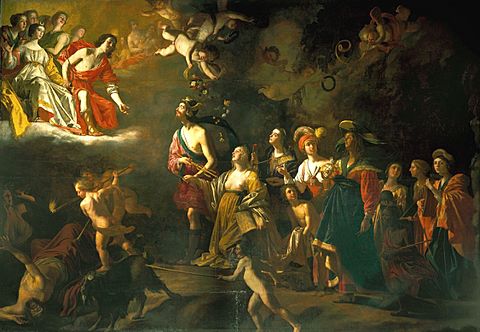
Popular prints, often based on his painted portraits, helped spread Buckingham's image. These prints are now part of the collection at the National Portrait Gallery. In 1628, during the political unrest before his assassination, Buckingham ordered another painting from Gerrit van Honthorst. This painting, The Liberal Arts presented to King Charles and Henrietta Maria, shows the duke as Mercury, the patron of the arts. He leads a procession of arts to the King and Queen, who are shown as Apollo and Diana.
Family Life
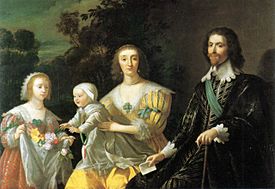
Buckingham married Lady Katherine Manners on May 16, 1620. She was the daughter of the 6th Earl of Rutland. Her father did not approve of the marriage.
They had four children:
- Mary Villiers (born before March 30, 1622 – died November 1685). She married three times.
- Charles Villiers, Earl of Coventry (born November 17, 1625 – died March 16, 1627). He died as a baby.
- George Villiers, 2nd Duke of Buckingham (born January 30, 1628 – died April 16, 1687).
- Lord Francis Villiers (born before April 21, 1629 – died July 7, 1648). He died in a small battle during the Second English Civil War.
Fictional Appearances
George Villiers, Duke of Buckingham, appears as a character in many stories.
In Books
He is a character in Alexandre Dumas's famous 1844 novel Les Trois Mousquetaires (The Three Musketeers). In the book, he is in love with Anne of Austria. The story also includes the siege of La Rochelle and his assassination.
Other historical novels that feature him include:
- The Arm and the Darkness (1943) by Taylor Caldwell.
- Wife to Great Buckingham (1959) by Hilda Lewis. This book focuses on his love for the French queen.
- Charles, The King (1963) by Evelyn Anthony.
- Darling Jasmine (2007) by Bertrice Small.
- El Capitán Alatriste (1996) by Arturo Pérez-Reverte. This Spanish novel includes the Spanish Match and an assassination attempt on Buckingham and Prince Charles.
- Earthly Joys (1998) by Philippa Gregory. This book is about the gardener John Tradescant the Elder.
- The Assassin (2004) by Ronald Blythe. This story is told from the killer's point of view.
In TV Shows
Nicholas Galitzine will play him in the upcoming TV miniseries Mary & George.
See also
 In Spanish: George Villiers (político inglés) para niños
In Spanish: George Villiers (político inglés) para niños



